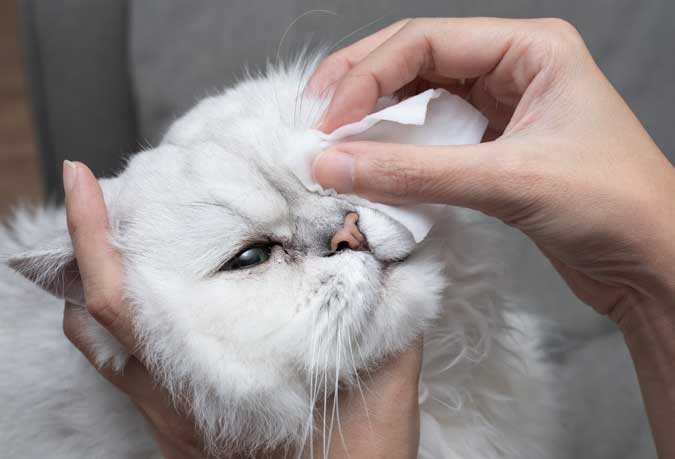Common Cat Eye Infections

A healthy cat's eyes are supposed to be bright and clear. So, if your cat's eyes have started to look more pink, foggy, or you have noticed your cat excessively pawing at them, these may be signs that your cat may have an eye infection. Let's talk about some of the common types of cat eye infections, how to spot them, and the appropriate treatment.
CONJUNCTIVITIS:

Conjunctivitis is the most common reason for feline eye disorders. Conjunctivitis is the inflammation of the thin membrane on the outer surface of the eye that covers the eyeball and lines the eyelids. When it is irritated, it can lead to one eye or both eyes becoming red and swollen. Symptoms include red eyes, frequent rubbing of the eyes, sneezing and coughing, eye discharge, or your cat wanting to keep their eyes closed. In most cases, the infection will self-resolve with no medication at all.
GLAUCOMA

Feline Glaucoma is an eye disease characterized by high eye pressure. When the healthy eye fluid that moves in and out of the lens of the eye is unable to drain normally, the accumulation of the fluid causes the eyeball to harden, which in turn leads to extreme pain and potentially blindness. According to Thomas Kern, Associate Professor of Ophthalmology at Cornell University, the disease is irreversible. While some of the pain and clinical signs may be relieved by using eyedrops, surgery to remove the eye is usually the most appropriate treatment option.
CATARACTS

The lens in a cat's eye is a structure that adjusts the shape as needed in order to focus light rays on the retina, a light sensitive layer of cells at the back of the eye. The retina then receives the light impulses and passes them to the brain as visual information. When the normally clear lens becomes cloudy, incoming light is prevented from getting to the retina and eventually leads to vision problems. While in some cases it won't lead to serious vision problems, in most cases, it usually leads to total blindness. This condition can be caused by a wide range of factors, From a cat's inability to metabolize proteins, conditions such as diabetes and sometimes, it can just be the byproduct of the aging process. The ideal treatment for cataracts is surgery. Fortunately, cataracts are not painful to our feline friends and cats are usually great at adjusting to blindness.
CORNEAL DISEASE

The cornea acts as a barrier against dirt and other harmful bacteria that can harm the eyes. It also acts as a window that focuses and controls the entry of light into the eye. While the cornea is able to quickly repair itself after injuries, a deeper injury can lead to total blindness. Symptoms include redness, corneal scarring, extreme sensitivity to light, etc. Corneal disease is not curable but appropriate treatment can achieve total control of the disorder.
PET INSURANCE

With surgery costs for these infections ranging from as little as $100 to as much as $4,000, the question that most of us have in mind is "how would I be able to afford my cat's treatment?"
One option to consider to help relieve some of the cost is pet insurance. The sentiment about pet insurance varies from person to person. While some folks will tell you that pet insurance is a waste of money, others will tell you how crucial it has been to helping them save the lives of their pets. Fortunately, pet insurance does not have to be expensive. With some cat rates being as low as $10 a month, you are essentially able to insure your pet for the price of a Netflix subscription.
CONCLUSION
There are many types of infections that can affect your cats eyesight, and they all have very similar symptoms. While same may not be as serious as others, it is always recommended to take a visit to the vet to rule out the more dangerous infections. Unfortunately, cats are very good at hiding pain and discomfort and make it hard to know if they are in pain. This makes it even more critical to constantly check for symptoms because some of the failing vision problems may be irreversible by the time they get veterinary help. As in all health problems, the earlier it is diagnosed, the better it may be treated.
Sources:
- https://www.vet.cornell.edu/departments-centers-and-institutes/cornell-feline-health-center/health-information/feline-health-topics/feline-vision-problems-host-possible-causes
- https://www.vet.cornell.edu/departments-centers-and-institutes/cornell-feline-health-center/health-information/feline-health-topics/feline-cataracts
- https://vcahospitals.com/know-your-pet/glaucoma-in-cats
- https://vcahospitals.com/know-your-pet/cataracts-in-cats
- https://www.valuepenguin.com/pet-insurance/average-cost-of-pet-insurance
Previous article

Next article

Related posts
View all-

What Can You Use Instead of Cat Litter?
Traditional cat litter is convenient, but it’s not the only option. Many cat owners look for alternatives to reduce waste, save money, or avoid chemicals found in clay-based kitty litter. Some options offer better odor control, while others are more eco-friendly or gentler on a cat’s paws.
Read Article -

How to Keep My Backyard Smelling Fresh
A clean backyard should smell fresh, unlike pet waste, smoke, or mold. Bad smells can linger, especially when dog poop, urine, or food scraps attract flies and bacteria. If your yard has a foul odor, it's time to take action. The first step is cleaning up pet feces, trash, or rotting food. A garden hose can wash away dirt and urine from artificial turf, patios, and decks. To neutralize odor, Use baking soda, white vinegar, and essential oils.
Read Article -

What Supplies Do First-Time Cat Owners Need?
Bringing home a new cat is exciting, but making them feel safe and comfortable takes more than love. First-time cat owners must prepare with the right supplies to ensure a smooth transition. From a litter box to cat food and a warm bed, having the basics ready can help your new kitty settle in faster. This guide covers everything a new cat owner needs to make their new pet feel at home.
Read Article



